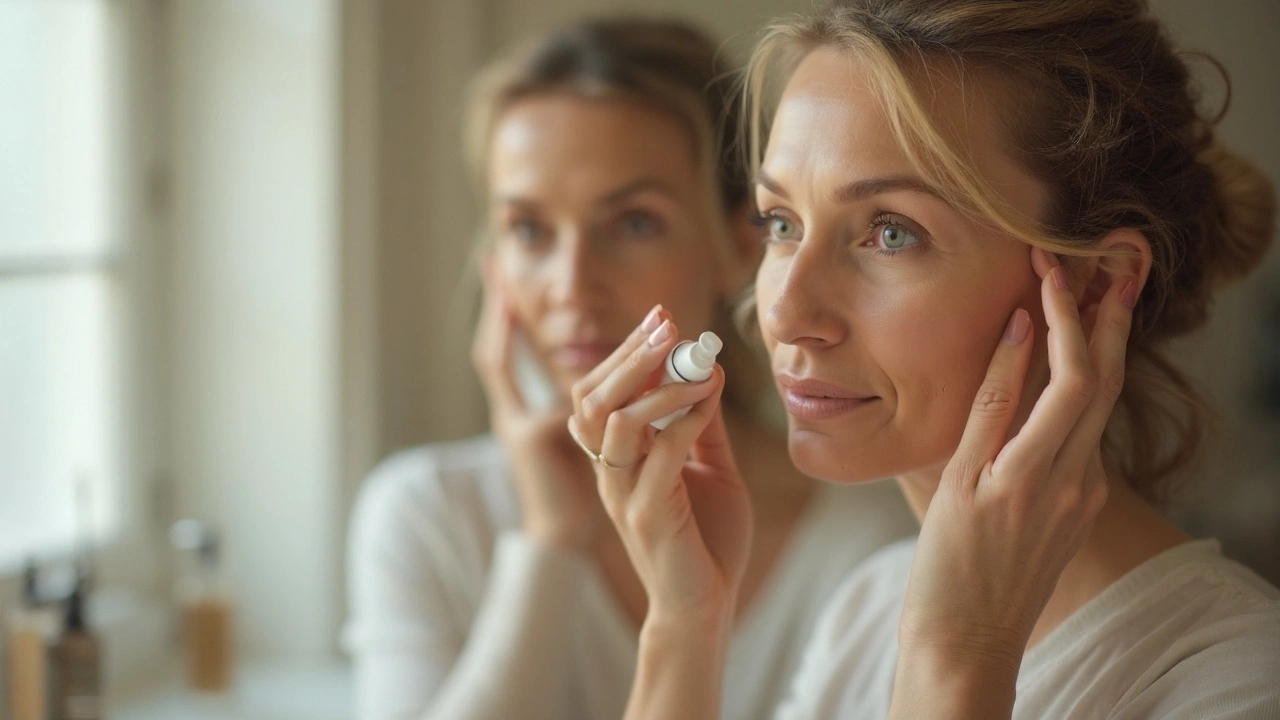Wrinkles pop up in bathroom mirrors and smartphone selfies before most of us expect them. Maybe you’ve run your finger over new lines near your eyes. Or caught yourself squinting at forehead creases you swear weren’t there last year. Here’s the thing: nobody escapes wrinkles forever. It doesn’t matter if you’re using the fanciest serums or sleeping only on your back. But what do real skin doctors swear by – and what’s just marketing? Spoiler: Forget the myths. Dermatologists trust proven science, not wishful thinking.
What Causes Wrinkles, and Why Do Some People Seem to Age Slower?
First myth to bust: Moisturizer alone won’t keep you wrinkle-free. Wrinkles form for a mix of reasons, and it goes way beyond dryness or stress. Genetics plays a big part in how your skin ages. If your parents got deep lines early, you might too—but it isn’t all set in stone. The two biggest skin-agers dermatologists can agree on? Sun exposure and smoking.
Let’s break it down. UV rays from sunlight mess with your skin’s collagen—the sturdy stuff that keeps skin firm and springy. When collagen weakens, skin turns slack and wrinkles set in. Smokes do the same but from the inside, limiting blood flow and starving your skin of what it needs. Even that fun after-work glass of wine every day adds up; alcohol dehydrates and adds to those wrinkles over time. And yep, squinting at screens or frowning lots can etch lines in certain spots. But here’s some good news: What you do every day matters even more than your genes.
Did you know that up to 90% of visible aging is related to sun damage? According to a study published in “Clinical, Cosmetic and Investigational Dermatology,” areas exposed to sunlight (like the face and hands) get wrinkles up to three times faster than less-exposed spots. That’s why dermatologists practically chant the word “sunscreen.”
Not all wrinkles are built the same, either. Fine lines can appear from dehydration. Deeper grooves happen as skin loses volume. Some folks have dynamic wrinkles from facial expressions, like crow’s feet or smile lines, and others develop static wrinkles that stick around no matter what your face is doing. Understanding the kind you have—or want to prevent—guides which fixes actually work.

Science-Backed Ingredients Dermatologists Actually Recommend
Step into any beauty aisle, and it’s dizzying. Collagen creams, gold-infused serums, devices that promise to erase ten years in ten minutes. Fact: The most potent anti-wrinkle ingredients have been around for decades.
Let’s start with the gold-standard: retinoids. Retinol and its prescription cousins (like tretinoin) ramp up cell turnover and stimulate collagen production underneath your skin. They shrink pores, fade age spots, and smooth fine lines. Studies going back 30 years confirm these results, and dermatologists themselves use retinoids nightly. You don’t need the strongest version to start; drugstore retinol works, especially when used long-term. Just use a pea-sized amount and expect some flaking or redness at first. Stick with it and moisturize like crazy.
Next up, sunscreen. Yes, again. Dermatologists agree it’s the only true “anti-aging” product you absolutely need. Daily SPF prevents new damage and stops existing wrinkles from deepening. The American Academy of Dermatology recommends a broad-spectrum sunscreen rated SPF 30 or higher, rain or shine.
Vitamin C feels like hype, but it’s not. This antioxidant brightens skin and—more importantly—neutralizes free radicals kicked up by sunlight and pollution. Regular morning use of a stable vitamin C serum means fewer brown spots and better skin texture over time. Combine vitamin C with sunscreen, and they work even better together. Dermatologists say apply vitamin C first, let it dry, then follow with SPF.
Chemical exfoliants, like glycolic or lactic acid, are one more tool. They clear away dead, dull surface skin so new, healthy cells can take over. Dermatologists advise starting with a once-a-week exfoliator and increasing as your skin gets used to it. Physical scrubs? Skip them. They often do more harm than good.
Hydrators like hyaluronic acid and peptides plump skin and can temporarily mask some fine lines. These give quick results but don’t rebuild collagen. Still, they’re great for smoothing out makeup and keeping skin comfortable, especially if you’re also using retinoids.
Here’s a handy reference chart on dermatologist-loved ingredients and what they actually do:
| Ingredient | Main Benefit | How to Use | Dermatologist Tip |
|---|---|---|---|
| Retinoids (Retinol/Tretinoin) | Boosts collagen, smooths wrinkles | At night, pea-sized amount | Moisturize after to reduce dryness |
| Sunscreen (SPF 30+) | Prevents new wrinkles, protects skin | Every AM, reapply outdoors | Apply enough to cover face and neck |
| Vitamin C | Brightens, stops free radicals | Morning, under SPF | Store away from light/air |
| AHAs/BHAs (Exfoliants) | Smooths texture, unclogs pores | Evenings, weekly at first | Don’t overdo, avoid scrubs |
| Peptides | Plumps, hydrates | Morning or night | Pairs well with hyaluronic acid |
Don’t forget the basics: A gentle cleanser, not soap, keeps skin happy. Ditch harsh alcohol-based toners. And don’t fall for anything that says “instant wrinkle remover”—at best, they temporarily fill lines or tighten skin with film-formers. The improvements fade in hours.

Professional Treatments and Small Everyday Habits That Actually Work
If you want faster, more dramatic results, dermatologists offer in-office options. Chemical peels use controlled acids to lift off dead outer layers and kick the body into “repair mode.” Light peels heal in a day while deeper ones may need downtime but can fade wrinkles and dark spots for real, lasting change.
Microneedling involves tiny needles poking the skin to prompt collagen growth. It sounds scary, but the discomfort is minor and it’s great for early lines and acne scars. Most people need a series (three to six treatments) for best results. When dermatologists add radiofrequency or specialized serums, the effects get an extra boost.
Lasers do more than erase old tattoos. Fractional resurfacing lasers zap precise columns of skin so new, fresher tissue grows in. These work on deeper wrinkles, sunspots, and skin texture. Side effects (like redness or swelling) can last a few days, but you’ll see improvements for months as collagen rebuilds. According to “Journal of the American Academy of Dermatology,” over 70% of patients see a visible difference after one or two laser sessions.
Injectables like Botox and Dysport work differently: they relax the muscles that create dynamic wrinkles (think crow’s feet and frown lines). Treatment is quick—less than 20 minutes—and results show gradually over ten days, lasting up to four months. Fillers are a separate option. Instead of freezing muscles, they plump deeper grooves or restore lost volume to cheeks and around the mouth. When done by an expert, these don’t look “fake.” Think subtle improvement, not cartoon-level smoothness.
Got a tight budget? Dermatologists insist that habits matter even more than treatments. Sleep on your back to avoid “pillow lines.” Wear sunglasses outdoors so you don’t squint and cause crow’s feet. Stick to a regular skincare routine—no skipping SPF, even when it’s cloudy or you’re indoors by a window. And yes, drinking water and eating colorful fruits and veggies (high in antioxidants) really does help your skin heal and look plumper. Eat a Mediterranean-style diet and your body gets less inflammation, meaning calmer, firmer skin.
One undeniable tip? Start sooner rather than later. Most people don’t feel urgency till wrinkles appear, but dermatologists are clear: prevention beats correction any day. Using dermatologists-recommended products in your 20s and 30s can pay off down the line. But it’s never too late to see improvement. Even those deep, stubborn lines can fade—maybe not completely, but enough to make your skin look fresher and healthier.
Don’t trust every “miracle cure” trending on TikTok or Instagram. Dermatologists get frustrated by wild claims: Snail slime serums? Maybe fun, zero proof. Jade rollers? Temporary puffiness fixes, nothing permanent. The best advice really hasn’t changed in decades: Sunscreen every single day, skip smoking, use a retinoid, and take care of your skin gently but consistently.
So the next time you catch a new line in the mirror, try not to panic or dump your wallet on miracle creams. Stick to what’s proven, change what you can, and let experience add character—as well as wisdom—to your face.
